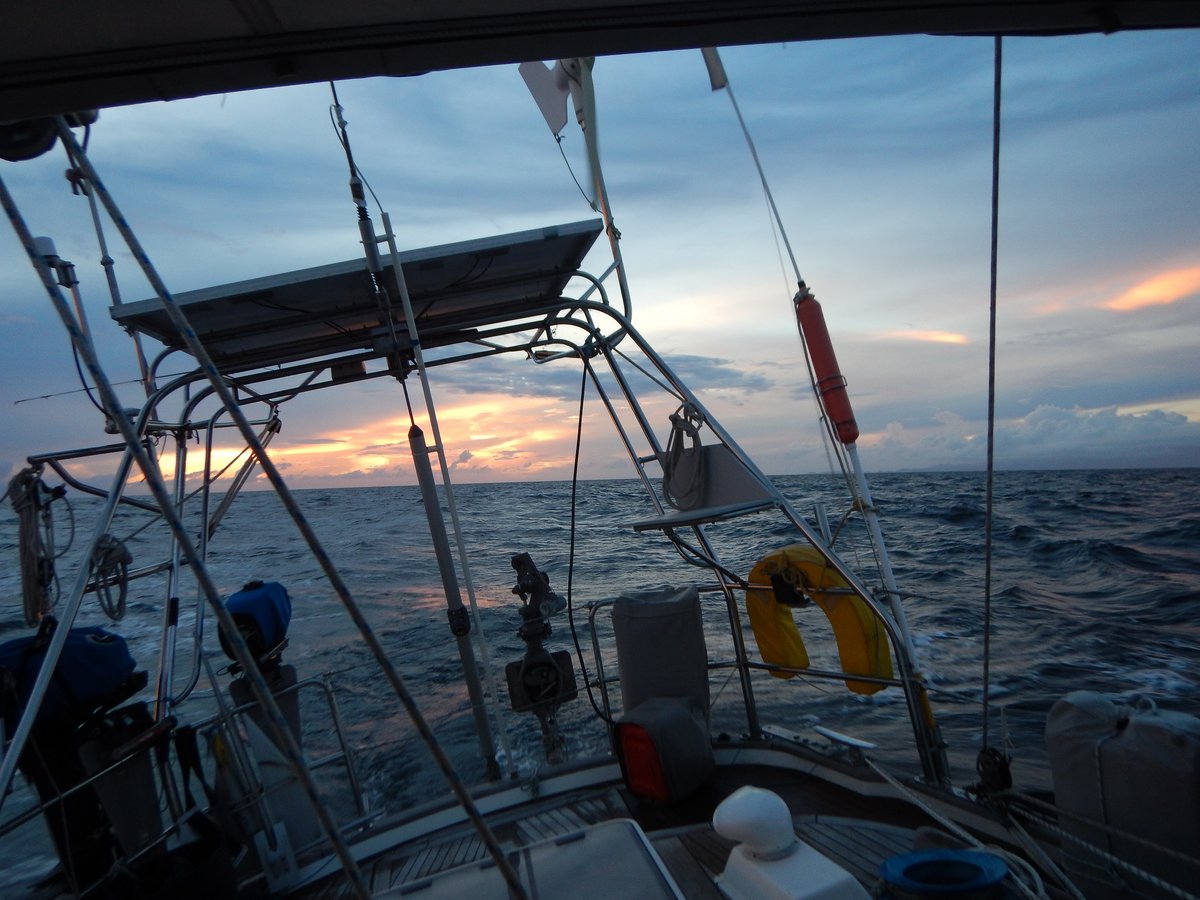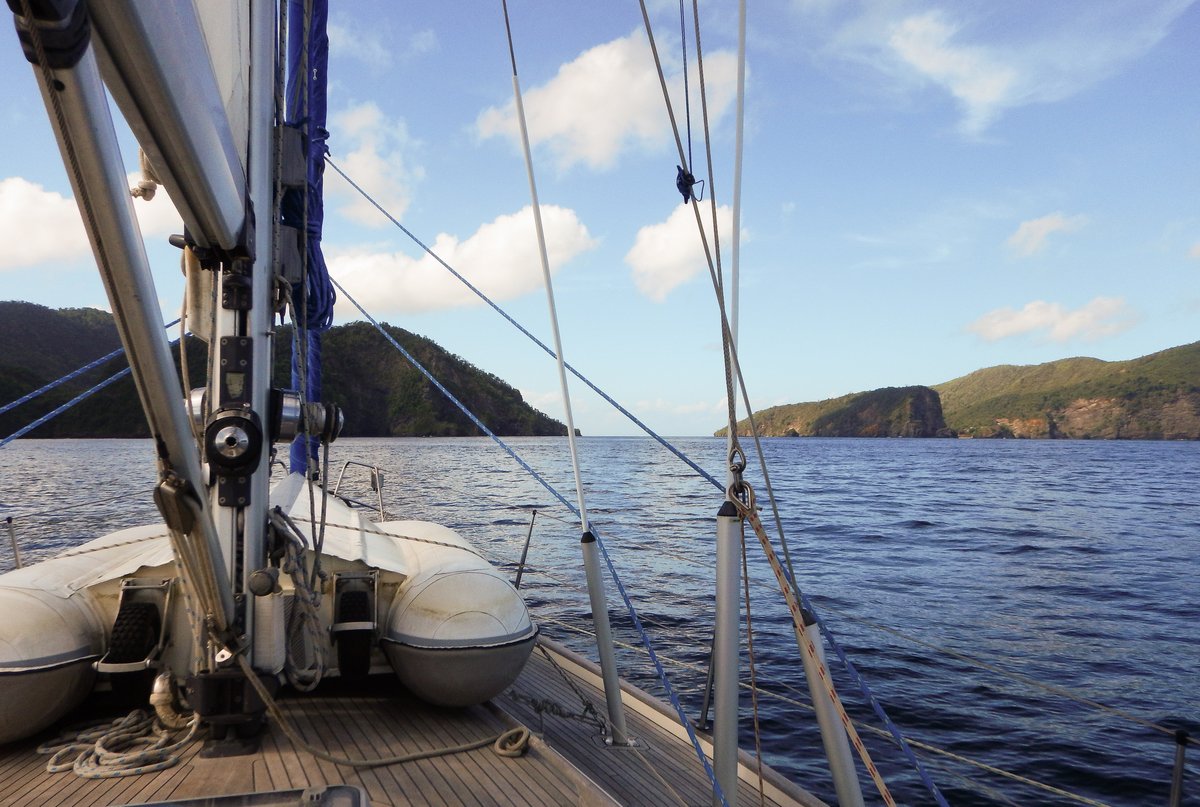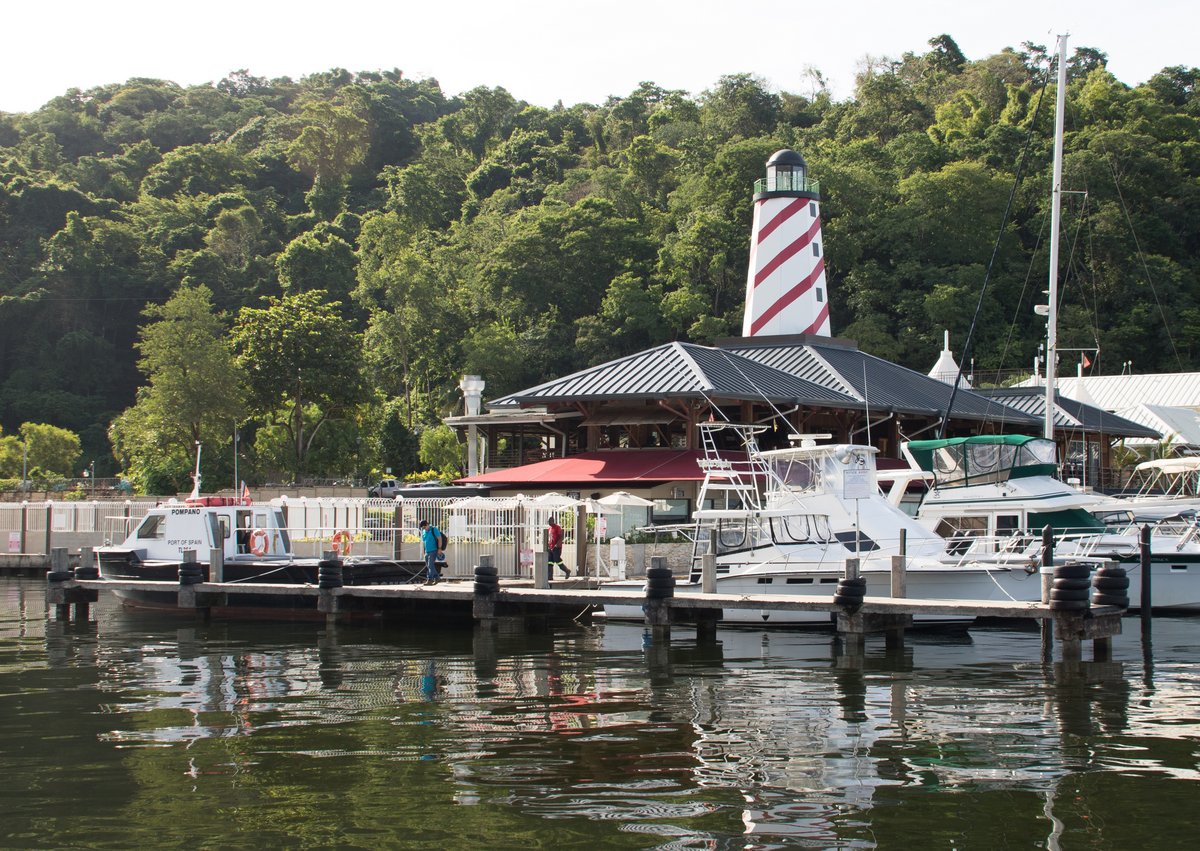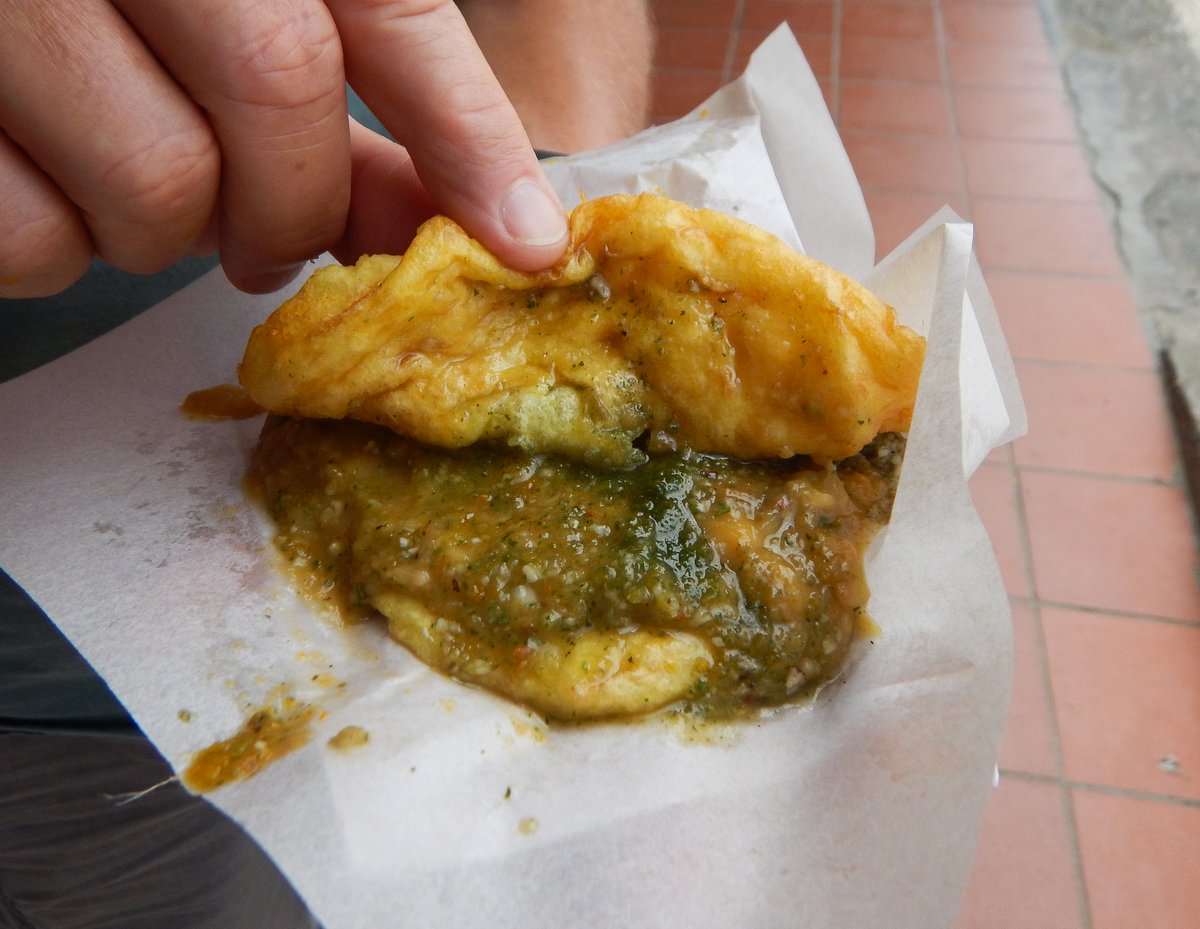21 June 2018 Grenada to Chaguaramus, Trinidad (Day 1)
It rained heavily early in the morning, which didn’t bode well for our night passage to Trinidad. There was a lull at 09:30, so I zipped around the corner to the customs and immigration office at Phare Blue marina. The marina has berths for about 40 boats, but it was very quiet with only 5 boats tied up.
There was a single customs lady in the office, who obviously had nothing to do, but she still kept me waiting for 10 minutes while she sorted out some personal crisis on the phone. Most of the officials in these Caribbean countries are surly and arrogant to the point of being rude. This lady displayed another common trait, which is to grow fingernails to an excessive length, I guess to show that they don’t do any physical labour.
The clearance process was very easy, the lady found my clearance record from when I cleared in; produced the clearance out; and printed four copies. I then had to wait fifteen minutes for the Immigration officer, who was out of the office, probably getting his second breakfast. Anyway, it was all completed within 45 minutes.
Back at the boat, we put the dinghy on deck and tidied up ready for sea. Glenys cooked a Cassoulet for dinner and we were all ready to go by lunch time. It’s 80 miles to the Bocas de Monas channel and a further 5 miles to the anchorage at Chaguaramus, so we reckoned with an average speed of 5 knots, it would take us 16 hours. We decided to leave a 16:00, which should get us to the channel at 08:00.
When we motored out of the bay, the wind was 15 -20 knots from the ESE as forecast, so we were expecting to be a little hard on the wind. Unfortunately, there was also a wicked 2 knot current pushing us west of the rhumb line, so to be able to hold our course over the ground, we were having to point 30 degrees higher than our required course.
We tried sailing hard on the wind, but the steep choppy waves were stopping us, slowing our boat speed down to below 2 knots at times, which allowed the current to push us further west. The only way that we could hold our course over the ground was to motor-sail with the wind at 30° - a very uncomfortable motion and frustrating when there’s reasonable wind strength.
Normally, we would have sailed as hard on the wind as we could manage and accept that we were being pushed west. Unfortunately, 10 miles to the west of the Bocas de Monas lies the Peninsula de Paria, which is part of Venezuela. Over the past 20 years, there have been many acts of piracy, violent robbery and even fatal shootings along the Venezuelan coast. We do not want to be going anywhere close to Venezuela.
To make matters worse, Venezuelans use fast pirogues to run drugs from the Peninsula de Paria along the north coast of Trinidad. A couple of years ago, there were four piracy attacks on yachts by armed men in fast pirogues. I’m guessing that these were opportunistic robberies, but we wanted to remain as far from Venezuela as possible.
It was a very frustrating night. We tried to sail, but on Glenys’s 10-1 watch, we were pushed 2 miles west in an hour, so it was back to motor-sailing. At times, we had 2 knots of current against us, reducing our speed over the ground to 3 knots. A few squalls hit us with a bit of rain, but there wasn’t much wind in them – maybe 25 knots, so we only had to slacken the main sheet rather than having to reef.
At 03:00, when we were 5 miles from the Hibiscus oil platform, the current finally slackened off and we were able to sail again, albeit hard on the wind. The wind and waves calmed down as we approached the coast of Trinidad and we had a good run until dawn.
22 June 2018 Grenada to Chaguaramus, Trinidad (Day 2)
At our 07:00 watch change, I pulled out the final reef from the main and we had a lovely sail for an hour. However, the wind died when we were 8 miles from the Bocas de Monas channel and we had to start the engine again. We motored through the narrow channel gazing up at the steep sided hills covered in jungle, while scored of pelicans circled above, riding the thermals looking for fish.
Around the corner, we passed the coast guard base and into Chaguaramus Bay. It’s a busy bustling place with a combination of boat yards that handle huge ships and small yachts. There are yachts anchored or moored in the corner of the bay, surrounded by large commercial ships.
It was 10:15 when we arrived, so we went straight to the Customs dock - the Customs and Immigration are notorious for charging overtime if you are clearing in during their lunch hour which starts at 12:00 precisely. The customs dock has not changed in 6 years - it’s a horrible concrete dock with a 12” thick platform, which is the only place you can fend off. There’s a steady stream of local boats going past the dock and the wash from them can easily pop out fenders, so I left Glenys on board and went to tackle the entry formalities.
Immigration was tedious because I had to fill out 6 forms, some of them in triplicate, using pieces of carbon paper. The lady was friendly, but the whole process took about 45 minutes even though I didn’t have to wait for anyone in front of me. The officer wanted to see Glenys, so I popped back to get her and she signed the relevant form. Customs was easy - just one form (in triplicate) and there was no one else in the office, so it took about 10 minutes. They only fee was $9US to customs.
Back at the boat, we called Coral Cove Marina and nipped across the narrow channel into our berth, which is alongside another horrible concrete dock, but we’re nicely held off by on the piles behind us.
After lunch, we had a kip and then went for a walk to familiarise ourselves with the boat yards and facilities. It’s not changed much in 6 years, so I know which businesses I’ll be using to do the various jobs on the boat. Unfortunately, there are no longer any ATM machines in Chaguaramus, so we’ll can only get some cash from the Malls or in Port of Spain - I managed to get the staff in the marina office to change $20US into Trinidad and Tobago dollars (TT).
With the vague possibility of being robbed by pirates on our way here, we took a few precautions and hid a few things away like the backup disks for my laptop and most of our cash. Glenys hid her credit cards away in the galley somewhere, but wouldn’t tell me where. Her logic was that I wouldn’t be able to blurt out where her stuff was if I was being tortured - I don’t know whether to be impressed or terrified.
23 June 2018 Chaguaramus, Trinidad
It’s very hot during the day, so we went for a walk to the various boat yards looking for someone to rent us an air conditioning unit. Unfortunately, the only guy who had one wanted $150USD for a month and wouldn’t rent for a shorter time. Oh well, it quite cool at night, so we’ll only suffer during the day.
We caught a mini-bus in to Port of Spain, which was an interesting ride - Trinidad is much more modern than the other islands with many flashy billboards and businesses. We were successful in getting some cash from one of the banks and then bought a SIM card for our phone. We then went for a stroll around the town, which hasn’t changed much.
Charlotte Street is a bustling place with scores of vegetable stalls and small shops selling a plethora of goods. We strolled around taking in the colourful scene and then stopped to have a Double. These are one of my favourite street foods. They put two 4” diameter chapatis on a piece of grease-proof paper and then slap on a generous helping of chick-pea curry. It’s incredibly messy to eat, but the taste is divine.
We caught the bus back towards Chaguaramus and stopped off at a large shopping mall, but it was incredibly boring with the usual collection of shops selling clothes, shoes and jewellery - we could have been anywhere in the world. We grabbed a disappointing taco for lunch and ran away.
It was a blistering afternoon, so back at the boat, we hid down below with all the fans running to move the air about. In the evening, we went out for a meal at Power Boats, which was rubbish.
24 June 2018 Chaguaramus, Trinidad
Being a Sunday, everywhere is closed, so we spent the morning planning our coming week and doing a few preparation jobs. We pickled the water-maker; removed the jack stays and preventers; washed the dinghy cover ready to be repaired; filled up with water and sorted out the 220V supply to our boat.
After lunch, it was too hot to work on deck, so we lurked down below. Later in afternoon, it rained very hard, which gave some relief from the humid heat.
25 June 2018 Chaguaramus, Trinidad
I was up early and started to tackle the jobs on my list, which mostly involved organising local tradesmen. I managed to catch Jonas from Trinidad Rigging on his way into work and he came to look at our boat as his first job. North Sails have always pointed at the bend in the mast and the main halyard tension as the reason for the bagginess in our main sail, so I wanted Jonas to check the rig before I bring in the North Sails Representative.
Jonas looked at the shape of the sail and then went up the mast to check the main furling at the top. He then did an inspection of the rig and checked the tension of the standing rigging. The verdict was that the rig is fairly well set up and the mast is a good shape without too much bend. He thinks that the main sail has too much draft and needs to be adjusted.
There are a few old toggles that he wants to replace and a disk which helps support the main sail extrusion has come loose inside the mast. I’ve got a few jobs for him to do, so he’s going to do the work while we’re in the UK - Jonas is one of the few people that I trust to do work while I’m away.
I went to see Mitch at West Coast Fabrications. Six years ago, he made our stern arch and did a cracking job. I only have a few small jobs for him this time, but he was pleased to see me. He’s going to make me a couple of small brackets in Stainless steel, for which he has quoted £35 instead of the £120 that a guy quoted in Grenada.
The rest of the day was a blur of running about trying to organise other vendors to come to look at jobs. I walked around to Peakes and confirmed the booking for the haul out on Monday 2 July.
26 June 2018 Chaguaramus, Trinidad
Kenwyn from Ullman Sails came to look at our sails. I had him look at the main sail and he came out with a bizarre statement saying that the main sail is designed to be fully out or completely rolled away. He claims that an in-mast main sail cannot be reefed. I’ve decided that I’m not going to allow him to touch my mainsail. However, I am happy for him to do the drudge work of some maintenance on the genoa and stay sail.
We took the sails across to his loft where he measured them up and inspected them. He says that the genoa still has some life in it, so he’s going to replace the sacrificial UV strip; repair a small tear and repair some damage to the luff tape. The stay-sail is in good condition apart from the sacrificial UV strip. It’s a long, tedious job to remove the old UV strip, so it’s going to cost us $9,800TT (£1,100) for both sails. (BOAT = Bring Out Another Thousand.)
While we were coming across the South Atlantic, I attached a block to the end of the pole through which I ran the genoa sheet to prevent chafe. Unfortunately, the block was rubbing against the pole fitting and after many days, it wore away part of the cast aluminium and the latch mechanism fell apart. A new end fitting is a staggering £380, but fortunately, I managed to retain all the latch parts, so I took the spinnaker pole around to Mitch who is going to repair it with weld, which will only cost £25.
The North Sails representative in Trinidad is Dynamite Marine and Mark came to have a look at mainsail. He pulled out the sail, reefed it, adjusted the tension of the foot and the leech, messed about with the topping lift and the rod kicker, but eventually agreed that the sail is too baggy when reefed. He thinks that the leech is too tight and the draft in the sail is too far back. We’ll wait and see what North Sails in the USA have to say.
Glenys pottered about the boat all day. She’s cleaned dinghy which was looking very grubby and has started to wash the various ropes on the boat. A carpenter came by and is going to give us a quote for a new teak grating in the front heads; cutting some marine plywood for new cupboard doors; replacing a mahogany trim in the front heads and a couple of varnishing jobs.
27 June 2018 Chaguaramus, Trinidad
Together with some other cruisers, we went on a day trip organised by Jesse James who runs a local taxi firm. The trip was entitled “Taste of Trini”, the idea being to see some of the island and to sample the local food.
We’d only gone a mile before Jesse made his first stop at a small roadside eatery and bought a local breakfast of saltfish, aubergine and some Bake, which is local fried bread. This was dished out in small portions amongst the nine people and we ate sat in the mini-bus. This set the trend for the whole day with Jesse screeching to a halt to buy curries, rice, bread, roti, fried chicken; pulled pork; cow heel soup; savoury pies; jack fruit; mangoes; chennet; and sweet pastries.
Altogether we made 30 stops, sampling over 50 dishes. By the end of the day, we were stuffed and barely able to eat the home-made ice cream bought from a vendor on the streets of Port of Spain
Jesse also took us to some interesting places, travelling down the west coast of Trinidad all the way down to the south coast. He’s a mine of information and gave us a non-stop commentary of Trinidad life as we passed through the small towns. There’s a large Indian population in Trinidad and we saw a couple of Hindu temples. At the Temple by the Sea, we witnessed two traditional Hindu cremations which were taking place at the edge of the sea.
We saw evidence of Trinidad’s volcanic environment with a stop at some mud pools bubbling with volcanic gas - a group of locals were plunging into the thick mud and then creating a mud slide by pouring bucket s of thick slimy mud down the hill - we didn’t join in. Jesse also took us past the Pitch Lake, which is one of the largest natural deposits of asphalt in the world. The road that goes through the area sinks and lifts up as the ash felt moves about and the local houses are built on floating foundations.
It was a long day, but very interesting and we just made it home by 20:00.
28 June 2018 Chaguaramus, Trinidad
Kool Keate, the fridge man came to have a look at our fridge, which has had a tiny leak for months. I’d already found the location of the leak because I could see oil covering one of the joints in the copper pipework. Keate pressurised the system; confirmed that the leak was on the joint and then repaired it with silver solder. The repair took about 2 minutes, but it took 2 hours to do the whole job; vacuum out the system and re-charge it. Total cost $120USD.
It threw it down for most of the afternoon, so I pottered about, while Glenys commandeered the saloon while she sewed patches onto the dinghy cover. There’s a small resident cruising community here, who organise events such as Yoga and Mexican Train Dominoes. We joined some of them for a pot luck dinner at the Roti Hut in Power Boats.
29 June 2018 Chaguaramus, Trinidad
Our friend Mike from “El Lobo” came for a cup of tea and we caught up on the last six years. He’s now living ashore with a Trinidadian lady, but still keeps in touch with the yachting community by hosting the cruiser’s net one day a week. He does a bit of carpentry and has a side line in looking after people’s boats while they are away.
Mike goes to the boat once a week; checks the stands; greases the stands to stop insects climbing aboard; opens the hatches to air the boat and generally checks that everything is OK, especially keeping a look out for the dreaded mildew. He only charges $75USD per month, so we’ve agreed that he’ll look after our boat for the 3 months that we’re away, which is a great load off my mind.
We had another day of running around. A second carpenter came to give us a quote. We nipped across to Ullman Sails to pay $5,000TT (£560) deposit for the work on our sail. They’re in the middle of changing banks, so their credit card machine doesn’t work which meant that we had to pay cash and the nearest ATM is 8 miles away, which was a hassle.
Just before lunch, we motored over to the fuel dock and filled up with diesel - it’s a good idea to have the fuel tanks full when on the hard to prevent water getting into the diesel from condensation. I’ve also added a big dose of diesel enzyme treatment which will absorb any water and prevent microbe growth in the fuel.
I received good news from North Sails. They have agreed that the mainsail needs adjusting and that they will do it free of charge. Of course, they don’t admit that the design of the sail was wrong, but instead say that they are “starting to believe the sail has stretched and become too full for good furling.” However, they are going to ship the sail to a North Sails loft and adjust it without any cost to me, which is a very good service considering that I’ve exceeded the normal warranty period of one year. We dropped the sail and put it in a bag. A guy from Dynamite Marine came around and picked up it 20 minutes later. Hopefully, it will be sorted out and back here for the first week of October.
We managed to tick quite a few things from our long list. Our cooking gas bottle was delivered to the boat having been filled; I picked up the spinnaker pole from Mitch and Glenys finished off the work on dinghy cover and started other little sewing jobs. We had a quiet night in and were in bed by nine o’clock.
30 June 2018 Chaguaramus, Trinidad
Glenys finished off all of her sewing projects, while I did some running around and a small repair one of the windlass foot switches. I then tackled the messy job of changing the oil on the engine and the generator - I don’t want to leave the corrosive dirty oil standing for 3 months.
In afternoon, I used a mixture of bleach, tri-sodium phosphate and a dash of washing up liquid to treat the teak deck to prevent mildew. I lightly sponged the mixture all over the deck, leaving it for 10 minutes and then hosing it off, but it took me a couple of hours of hard graft on my hands and knees.
We haul out on the 2nd July and we’ve now done most of the jobs on our list. Once we’re on the hard, we’re going to be staying in a hotel room for three nights, so we’re going to concentrate on some messy varnishing projects, which are hard to do while living on the boat.
There are more photos in our Photo Album section.
- << Prev
- Next









